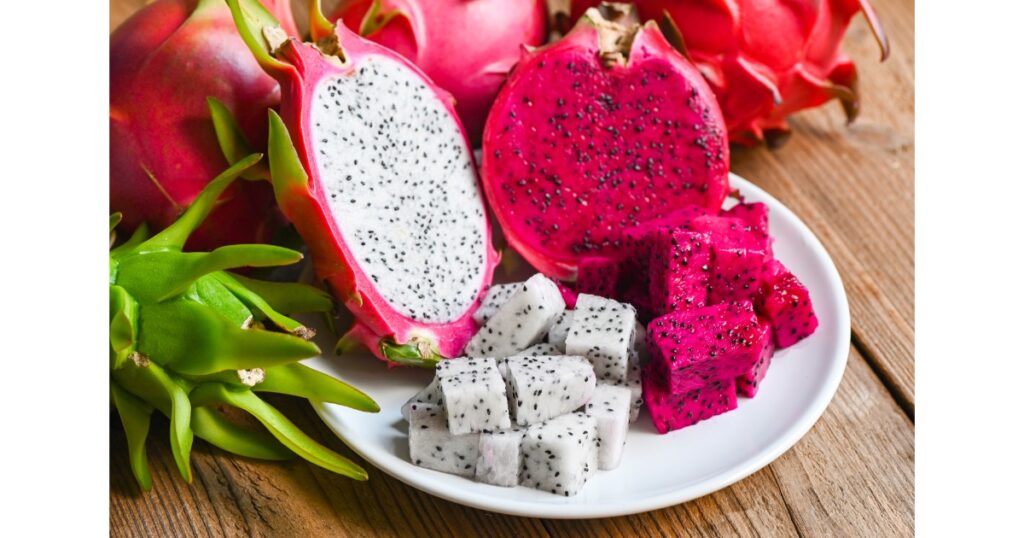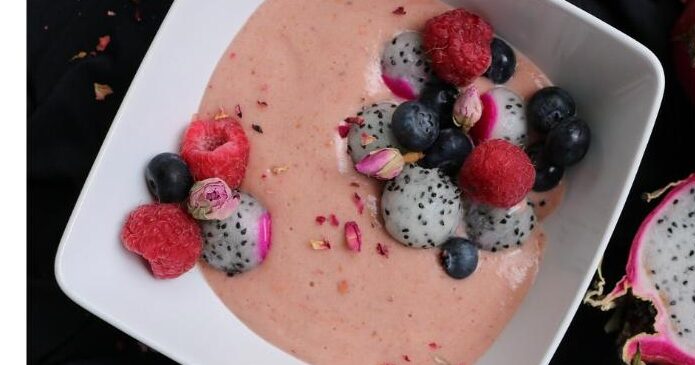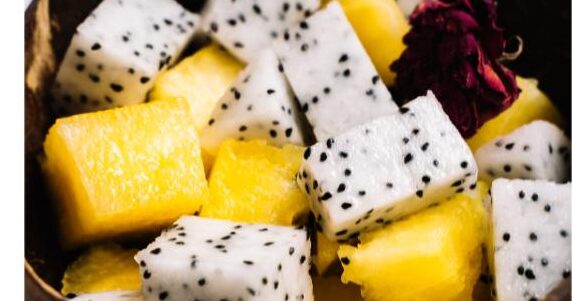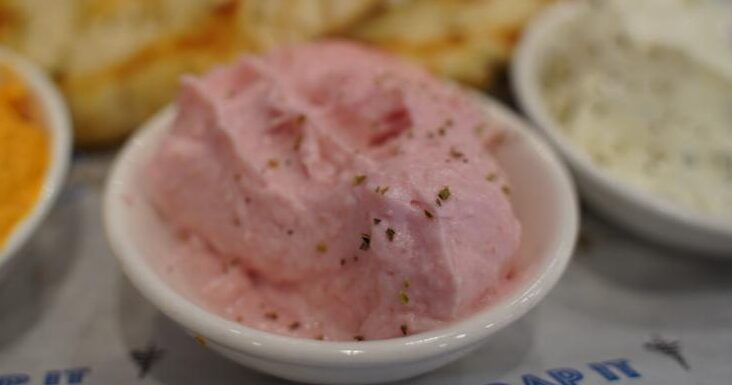In a world filled with superfoods, one exotic fruit is making waves these days – dragon fruit. This fruit’s vibrant, scaly exterior hides a treasure trove of health benefits.
Let’s get acquainted with the basics before we get into the health benefits. What exactly is dragon fruit?
Table of Contents
What is Dragon Fruit?
Dragon fruit, scientifically known as Hylocereus undatus, is a tropical fruit originating from the cactus family. Its outer skin is often vibrant and scaly, ranging from pink and red to yellow. The inner flesh, dotted with tiny black seeds, can be white, red, or magenta, depending on the variety.
Wondering what makes this fruit a nutritional powerhouse?
It is packed with essential vitamins, minerals, and antioxidants, making it a valuable addition to any diet.
The dragon fruit plant, or pitaya cactus, is a climbing cactus that thrives in warm, arid climates. It has slender, elongated stems that serve as its branches.
One of the remarkable qualities of the dragon fruit plant is its adaptability to different environments. It can thrive in a variety of soils and is relatively low-maintenance, making it suitable for cultivation in diverse regions.
Despite the name “dragon fruit tree” commonly used, it’s important to note that dragon fruit is not borne on trees.
Dragon Fruit Nutrition
How does this fruit stack up against other popular superfoods? We’ll break down the nutritional content, helping you make informed decisions about what goes into your body.
Here is the nutritional value of dragon fruit per 100 grams.
| Nutrient | Value |
| Energy | 57 kcal |
| Protein | 0.36 g |
| Fat | 0.14 g |
| Carbohydrate | 15.2 g |
| Dietary Fiber | 3.1 g |
| Calcium | 9 mg |
| Potassium | 116 mg |
| Vitamin C | 4.3 mg |
| Folate | 7 mcg |
| Beta-Carotene | 14 mcg |
| Choline | 5.1 mg |
| Phosphorus | 12 mg |
| Magnesium | 7 mg |
Types of Dragon Fruit
There isn’t just one type of dragon fruit, there are several. Each type comes with its own set of characteristics, flavours, and nutritional benefits. Let’s take a closer look at the diverse world of dragon fruit varieties.
Red Dragon Fruit
Distinguished by its vivid pink or red skin and striking magenta flesh, the red-fleshed dragon fruit is a visual delight. Its slightly sweeter taste adds a burst of flavour to culinary creations.
Pink Dragon Fruit
This is the most common variety, recognized by its vibrant pink skin and white flesh speckled with tiny black seeds. The subtle sweetness of the white-fleshed dragon fruit makes it a versatile addition to various dishes.
Yellow Dragon Fruit
The yellow dragon fruit, often referred to as the yellow pitahaya, stands out with its bright yellow skin and white or yellow flesh. Its taste is subtly sweet with a hint of tartness.
Purple Dragon Fruit
The purple dragon fruit, also known as the Thai dragon fruit or purple pitahaya, features a distinctive reddish-purple exterior with green scales. True to its name, the purple dragon fruit boasts vibrant purple flesh.
Blue Dragon Fruit
The blue dragon fruit, also known as the Costa Rican pitaya or blue pitahaya, is distinguished by its vibrant, deep magenta to violet skin. The outer appearance, combined with its contrasting green, spiky scales, creates an enchanting visual appeal.
Research-Based Dragon Fruit Benefits

Here are the top reasons and benefits of eating dragon fruit.
Low in Calories, Rich in Nutrients
Imagine dragon fruit as a nutrition-packed superhero when you’re watching your calories. It provides your body with essential nutrients without weighing you down, making it perfect for those aiming to manage their weight.
Rich in Antioxidants
Dragon fruit’s powerful antioxidants, such as betalains, betaxanthins, betacyanins, rutin, myricetin, and, flavonoids fight off harmful free radicals.1
Just like a shield, these antioxidants help defend your cells from damage, potentially lowering the risk of chronic diseases like heart problems and cancers.
These antioxidants are responsible for the bright and beautiful colours of dragon fruit.
Packed with Vitamin C
Dragon fruit is your immune system’s best friend. Packed with vitamin C, it provides a robust defense against colds and infections.
This nutrient helps keep your immune system in top shape along with supporting other functions like collagen production.
Dietary Fibre-Rich
Dragon fruit’s fibre content is gut-friendly and superb for your digestive system. It keeps things moving smoothly, preventing clogs and promoting healthy digestion.
Fibre is your ally in maintaining a balanced gut, which not only aids in digestion but also supports your overall well-being.
Prebiotic Effect
Oligosaccharides are the type of carbohydrates present in dragon fruit.
It has been observed that these carbs exert a prebiotic effect on digestion by stimulating the growth of gut-friendly bacteria like Bifidobacteria and Lactobacillus, on digestion.
Source of Iron & Magnesium
If you often feel like you’re running low on energy or feeling fatigued, this wonder fruit has got your back.
Packed with iron and magnesium, it helps fuel your body’s energy production, supports muscle function, and prevents that “drained” feeling. Consider it your natural energy boost.
May Aid in Blood Sugar Control
For those battling insulin resistance or diabetes, dragon fruit might be a boon.
Research suggests it could help regulate blood sugar levels, providing hope for individuals managing diabetes and striving for better control over their sugar levels.
Heart-Healthy Nutrients
With its heart-healthy nutrients, this fruit may help maintain cholesterol levels, reducing the risk of heart-related issues. It’s a tasty way to show your heart some love.
A study2 published in the American Journal of Clinical Nutrition observed that people who consume dragon fruit daily are less prone to diabetes and cardiovascular diseases due to the presence of a compound called betalain.
Hydration Support
With its high water content, it quenches your thirst and keeps you hydrated. Proper hydration is the key to keeping your body’s engines running smoothly.
Anti-Inflammatory Effects
Dragon fruit is like a soothing balm for inflammation woes.
Certain compounds in the fruit may help calm chronic inflammation, offering relief to those dealing with conditions where inflammation plays a role, such as arthritis or digestive issues.
Studies3 support that anthocyanins and other antioxidants present in dragon fruit have the potential to control and manage inflammatory processes significantly.
Support Bone Health
With phosphorus, calcium, and vitamin C, it contributes to strong bones and teeth. It’s like giving your skeleton the supporting nutrition it needs to stay solid and resilient.
Dragon Fruit Side Effects You Need To Know
While dragon fruit is generally safe for most people, some people might experience potential side effects. We’ll discuss potential allergic reactions and precautions to take.
- In some individuals, its consumption may lead to allergic reactions. Symptoms can include itching, swelling or difficulty breathing.
- People who are allergic to other fruits, particularly those in the cactus family, may be more prone to dragon fruit allergies.
- Eating dragon fruit in excessive amounts may cause mild gastrointestinal issues such as diarrhoea or an upset stomach. As with any food, moderation is the key.
- As with any food, this fruit may interact with certain medications. Individuals taking medications for blood pressure, diabetes, or other conditions should consult their healthcare provider to ensure there are no potential conflicts.
- Dragon fruit contains oxalates, which are compounds that can contribute to the formation of kidney stones in susceptible individuals.
- While this fruit is generally safe, pregnant and breastfeeding women should consult with their healthcare providers before making it a regular part of their diet.
A Step-by-Step Guide on How to Cut Dragon Fruit?
- Choose a dragon fruit that is slightly soft to the touch but not mushy. The ripe one should have a vibrant colour and yield slightly when pressed.
- Place the fruit on the cutting board, and using your sharp knife, slice off both ends. This creates stable bases for the fruit to stand on during the cutting process.
- Stand the dragon fruit upright on one of the cut ends. With a steady hand, carefully cut the fruit vertically into two halves, each exposing the white or colourful flesh and tiny black seeds.
- Use a spoon to gently scoop it out from each half.
- Its skin can have small, spiky protrusions, so handle it with care to avoid any prickly encounters.
5 Delicious Dragon Fruit Recipes to Try
Here are some easy and nutritious recipes that you can try at home.
Dragon Fruit Smoothie

Ingredients:
- 1 dragon fruit, scooped
- 1 frozen banana
- 1/2 cup Greek yoghurt
- 1/2 cup almond milk
- Toppings: berries, chia seeds, and chopped nuts
Recipe:
- Blend the dragon fruit, frozen banana, Greek yoghurt, and almond milk until smooth.
- Pour the smoothie into a glass or jar.
- Top with berries, chopped nuts and seeds.
Dragon Fruit Salad

Ingredients:
- 1 dragon fruit, cubed
- 1 cup strawberries, sliced
- 1 cup pineapple chunks
- 1 cucumber, diced
- Fresh mint leaves
- Lime juice for dressing
Recipe:
- In a large bowl, combine dragon fruit, strawberries, pineapple, and cucumber.
- Drizzle lime juice over the fruits for a refreshing dressing.
- Toss the salad gently to mix.
- Garnish with fresh mint leaves.
Dragon Fruit Salsa

Ingredients:
- 1 dragon fruit, diced
- 1 cup diced mango
- 1/2 red onion, finely chopped
- 1 jalapeño, seeds removed and finely chopped
- Fresh coriander, chopped
- Lime juice and salt to taste
Recipe:
- In a bowl, combine diced dragon fruit, mango, red onion, jalapeño, and chopped coriander leaves.
- Squeeze lime juice over the mixture and add a pinch of salt.
- Mix well and let it sit for flavours to meld.
- Serve the dragon fruit salsa with whole-grain tortilla chips or as a topping for grilled paneer or chicken.
Dragon Fruit Yogurt Parfait

Ingredients:
- 1 dragon fruit, cubed
- Greek yoghurt
- Granola
- Honey (optional)
Recipe:
- In a glass or bowl, layer Greek yoghurt at the bottom.
- Add a layer of cubed dragon fruit.
- Sprinkle granola over the dragon fruit layer.
- Repeat the layers until you reach the top.
- Drizzle honey on the top layer for sweetness.
Dragon Fruit Popsicles

Ingredients:
- 2 cups diced dragon fruit
- 1/4 cup honey
- 1 cup coconut water
Recipe:
- Blend the dragon fruit, honey, and coconut water until smooth.
- Pour the mixture into popsicle molds.
- Freeze for at least 4-6 hours or until solid.
Summary
In conclusion, the dragon fruit emerges not just as a visually stunning tropical delight but as a nutritional powerhouse offering a myriad of health benefits. From being rich in antioxidants that combat free radicals to providing a significant vitamin C boost for immune support, dragon fruit stands as a versatile ally in promoting overall well-being.
Beyond its health benefits, dragon fruit brings a burst of colour to your plate and comes in various varieties, each with its unique flavour and appearance. Whether you opt for the vibrant pink skin with white flesh or the striking yellow skin with red or white flesh, each variety promises a delightful taste experience.
Your body will thank you for the burst of nutrients, and your taste buds will celebrate the addition of a delicious and nutritious ally.
Cheers to the vibrant world of dragon fruit!
Frequently Asked Questions
Is dragon fruit high in sugar?
Dragon fruit does contain natural sugars, but it is not excessively high. Compared to many other fruits, it has a relatively low sugar content. Moderation is the key, especially for individuals monitoring their sugar intake.
Is dragon fruit good for weight loss?
Yes, it can be a valuable addition to a weight-loss diet. It is low in calories, high in fibre, and nutrient-dense, making it a satisfying and healthy snack or meal component.
Is dragon fruit good for diabetes?
It can be a suitable fruit choice for individuals with diabetes. Its fibre content may help regulate blood sugar levels. However, as with any dietary changes, individuals with diabetes need to monitor their blood sugar and consult with their healthcare provider.
What is the difference between the different colours of dragon fruit?
The different colours of dragon fruit, such as red, white, or yellow, primarily indicate the variety. While the taste is similar, some people claim subtle flavour differences. Nutrient-wise, they are all packed with antioxidants, vitamins, and fibre.
How do you know if a dragon fruit is ripe?
A ripe fruit should have bright, evenly coloured skin and give slightly when pressed. The skin may also have some small blotches. If it’s too firm, it’s likely not fully ripe, while overly soft skin may indicate overripeness.
Is dragon fruit good for hydration?
Absolutely! With its high water content, dragon fruit contributes to hydration. Including hydrating foods like dragon fruit in your diet is an excellent way to support overall fluid balance.
How to eat dragon fruit?
Dragon fruit can be sliced and eaten on its own, added to fruit salads, blended into smoothies, used in yogurt parfaits, or even included in savoury dishes like salsas. Its mild flavour makes it versatile for both sweet and savoury recipes.
Can pregnant women eat dragon fruit?
It is advisable for pregnant women to consult with their healthcare provider to ensure that their dietary choices align with their individual health needs and any specific conditions they may have. While dragon fruit is generally safe, individual responses to foods can vary, and it’s crucial to consider one’s overall dietary balance during pregnancy.
What are some dragon fruit benefits for skin?
Antioxidants in dragon fruit protect the skin from oxidative stress caused by environmental factors like pollution and UV rays, contributing to healthier and more youthful-looking skin. It contains vitamin C, a crucial component for collagen synthesis. Additionally, the anti-inflammatory and antioxidant properties of dragon fruit may contribute to minimizing redness and inflammation associated with acne, promoting clearer and healthier skin.
What is the dragon fruit calories content?
1 cup (180 grams) provides 103 calories.
List common dragon fruit vitamins.
Dragon fruit is rich in vitamins A, C, E, K and B vitamins.
- Paśko, P., Galanty, A., Zagrodzki, P., Luksirikul, P., Barasch, D., Nemirovski, A., & Gorinstein, S. (2021). Dragon Fruits as a Reservoir of Natural Polyphenolics with Chemopreventive Properties. Molecules, 26(8), 2158. https://doi.org/10.3390/molecules26082158 ↩︎
- Cheok, A., Xu, Y., Zhang, Z., Caton, P., & Rodríguez-Mateos, A. (2022). Betalain-rich dragon fruit (pitaya) consumption improves vascular function in men and women: a double-blind, randomized controlled crossover trial. The American Journal of Clinical Nutrition, 115(5), 1418–1431. https://doi.org/10.1093/ajcn/nqab410 ↩︎
- Nishikito, D. F., Borges, A. C. A., Laurindo, L. F., Otoboni, A. M. M. B., Direito, R., De Álvares Goulart, R., Nicolau, C. C. T., Fiorini, A. M. R., Sinatora, R. V., & Barbalho, S. M. (2023). Anti-Inflammatory, antioxidant, and other health effects of dragon fruit and potential delivery systems for its bioactive compounds. Pharmaceutics, 15(1), 159. https://doi.org/10.3390/pharmaceutics15010159 ↩︎

Awesome information… very detailed yet concised!! The hands-on recipes are a great way to actually consume them!!
Thank you for sharing this Navneet!! 🙂